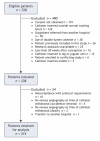Incidence of deep vein thrombosis related to peripherally inserted central catheters in children and adolescents
- PMID: 17978273
- PMCID: PMC2043066
- DOI: 10.1503/cmaj.070316
Incidence of deep vein thrombosis related to peripherally inserted central catheters in children and adolescents
Abstract
Background: Peripherally inserted central catheters (PICC) in children and adolescents are being used with increasing frequency. We sought to determine the incidence and characterize risk factors of deep vein thrombosis associated with peripherally inserted central catheters in a pediatric population.
Methods: We conducted a prospective study involving consecutive patients referred to the radiology department of a tertiary care university-affiliated hospital for insertion of a peripherally inserted central catheter. We included patients aged 18 years or less who weighed more than 2.5 kg and had a peripherally inserted central catheter successfully inserted in his or her arm between June 2004 and November 2005. The primary outcome was the occurrence of partial or complete deep vein thrombosis evaluated by clinical examination, ultrasonography and venous angiography.
Results: A total of 214 patients (101 girls, 113 boys) were included in the study. Partial or complete deep vein thrombosis occurred in 20 patients, for an incidence of 93.5 per 1000 patients and 3.85 per 1000 catheter-days. Only 1 of the cases was symptomatic. In the univariable analyses, the only variable significantly associated with deep vein thrombosis was the presence of factor II mutation G20210A (odds ratio 7.08, 95% confidence interval 1.11-45.15, p = 0.04), a genetic mutation that increases the risk of a blood clot and that was present in 5 (2.3%) of the 214 patients.
Interpretation: The incidence of deep vein thrombosis related to peripherally inserted central catheters in our study was lower than the incidence related to centrally inserted venous catheters described in the pediatric literature (11%-50%).
Figures
Similar articles
-
Incidence and risk factors of superficial and deep vein thrombosis associated with peripherally inserted central catheters in children.J Thromb Haemost. 2016 Nov;14(11):2158-2168. doi: 10.1111/jth.13478. Epub 2016 Oct 12. J Thromb Haemost. 2016. PMID: 27558946
-
Incidence of thrombosis in children with tunneled central venous access devices versus peripherally inserted central catheters (PICCs).Thromb Res. 2013 Nov;132(5):527-30. doi: 10.1016/j.thromres.2013.08.018. Epub 2013 Aug 30. Thromb Res. 2013. PMID: 24055175
-
Peripherally inserted central catheters inserted with current best practices have low deep vein thrombosis and central line-associated bloodstream infection risk compared with centrally inserted central catheters: A contemporary meta-analysis.J Vasc Access. 2021 Jan;22(1):9-25. doi: 10.1177/1129729820916113. Epub 2020 May 1. J Vasc Access. 2021. PMID: 32356479
-
Peripherally inserted central catheter-related thrombosis rate in modern vascular access era-when insertion technique matters: A systematic review and meta-analysis.J Vasc Access. 2020 Jan;21(1):45-54. doi: 10.1177/1129729819852203. Epub 2019 Jun 10. J Vasc Access. 2020. PMID: 31177939
-
Association between delivery methods for red blood cell transfusion and the risk of venous thromboembolism: a longitudinal study.Lancet Haematol. 2016 Dec;3(12):e563-e571. doi: 10.1016/S2352-3026(16)30132-6. Epub 2016 Nov 3. Lancet Haematol. 2016. PMID: 27818170 Clinical Trial.
Cited by
-
Incidence and acute complications of asymptomatic central venous catheter-related deep venous thrombosis in critically ill children.J Pediatr. 2013 Feb;162(2):387-91. doi: 10.1016/j.jpeds.2012.06.059. Epub 2012 Aug 9. J Pediatr. 2013. PMID: 22883418 Free PMC article.
-
A review of peripherally inserted central catheters and various types of vascular access in very small children and pediatric patients and their potential complications.J Med Life. 2021 May-Jun;14(3):298-309. doi: 10.25122/jml-2020-0011. J Med Life. 2021. PMID: 34377194 Free PMC article. Review.
-
Biomarkers Associated with Thrombosis in Patients with Peripherally Inserted Central Catheter: A Systematic Review and Meta-Analysis.J Clin Med. 2023 Jul 4;12(13):4480. doi: 10.3390/jcm12134480. J Clin Med. 2023. PMID: 37445515 Free PMC article. Review.
-
Tunneled and routine peripherally inserted central catheters placement in adult and pediatric population: review, technical feasibility, and troubleshooting.Quant Imaging Med Surg. 2021 Apr;11(4):1619-1627. doi: 10.21037/qims-20-694. Quant Imaging Med Surg. 2021. PMID: 33816196 Free PMC article. Review.
-
[Prevention of perioperative venous thromboembolism in children].Wien Med Wochenschr. 2009 Oct;159(19-20):481-6. doi: 10.1007/s10354-009-0712-6. Wien Med Wochenschr. 2009. PMID: 19898787 Review. German.
References
-
- Beck C, Dubois J, Grignon A, et al. Incidence and risk factors of catheter-related deep vein thrombosis in a pediatric intensive care unit: a prospective study. J Pediatr 1998;133:237-41. - PubMed
-
- Bozzetti F, Scarpa D, Terno G, et al. Subclavian venous thrombosis due to indwelling catheters: a prospective study on 52 patients. JPEN J Parenter Enteral Nutr 1983;7:560-2. - PubMed
-
- Lokich JJ, Becker B. Subclavian vein thrombosis in patients treated with infusion chemotherapy for advanced malignancy. Cancer 1983;52:1586-9. - PubMed
-
- Valerio D, Hussey JK, Smith FW. Central vein thrombosis associated with intravenous feeding — a prospective study. JPEN J Parenter Enteral Nutr 1981;5:240-2. - PubMed
-
- Glaser DW, Medeiros D, Rollins N, et al. Catheter-related thrombosis in children with cancer. J Pediatr 2001;138:255-9. - PubMed
Publication types
MeSH terms
LinkOut - more resources
Full Text Sources
Medical


